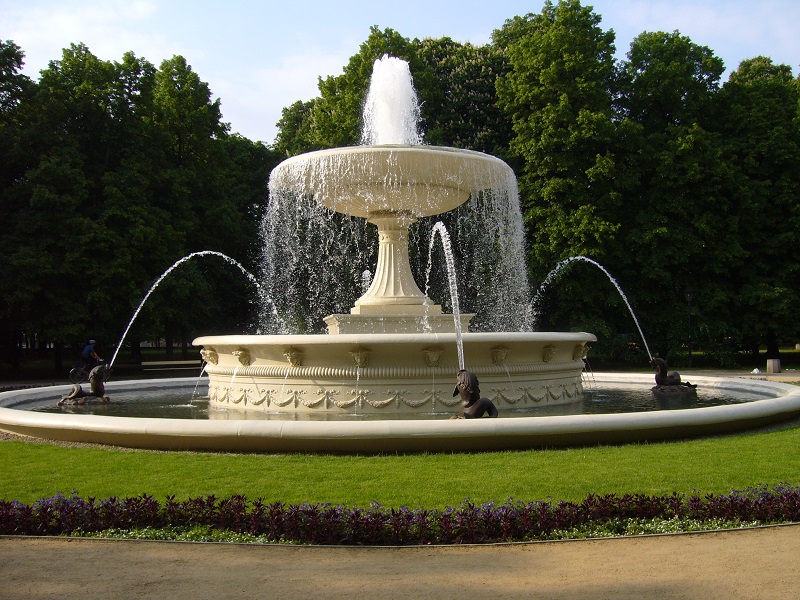Fountain
A fountain is an architectural feature which involves water and is often used as part of landscaping. A fountain can either pour water into a basin to create a ‘waterfall effect’ or spray water into the air to create a ‘jet effect’. Fountains are often used as decorative features in public spaces and gardens.
Drinking fountains are used to provide drinking water public spaces, and special musical fountains combine lights, music and moving water jets for purposes of entertainment. Splash fountains are often used in public spaces and intended for interaction.
The earliest fountains, in Ancient Rome, were functional and used for providing water for drinking and washing. For a water flow to be consistent it required a source (e.g. reservoir or aqueduct) that was higher than the fountain and so was reliant on gravity.
By the end of the 19th century, fountains had been replaced as the main source of drinking water by domestic plumbing and so became primarily decorative. At around this time, gravity was replaced by mechanical pumps which enabled fountains to recycle water and project it into the air. At the start of the 20th century, fountains began to adopt steam pumps and then later on electric pumps to receive water from the source.
Modern fountains rely on a closed recirculating system to recycle water. An electric pump is used to provide the power to push water through the pipes. The pump is typically submerged in the water reservoir and consists of a spinning impellor to draw water in and force it out by centrifugal force. The most appropriate pumping rate will need to be found as the fountain can splash and waste water if it is set too high and will not circulate at all if it is set too low.
Water is delivered to the fountain head and then sprayed into the air through a nozzle or left to flow outside the fountain. In both cases the water will fall back onto the fountain and drain back into the reservoir. Larger fountains will often be fitted with multiple nozzles and pumps.
A filter known as a media filter, is used to remove particles from the water as it is circulated. It is fitted with its own pump and plumbing to take water from the pool to the filter and back to the pool. The water can be cleaned using treatments such as chlorination or anti-algal methods.
A ‘plant room’ is provided to store the pumps, filter, electrical switch box and plumbing controls, and this must be well-constructed so as not to leak and create a hazard. Fountains can often use low-voltage lighting, often submerged in the water, which minimises hazards.
Water in a fountain is gradually lost due to evaporation so it must be topped up at certain times, and allowances made to be able to cope with overflow after heavy rain.
Some notable fountains include:
- King Fahd’s Fountain, Jeddah, Saudi Arabia: Jets water 260 m into the air making it the world’s highest continually-running fountain.
- Jet d’Eau fountain, Geneva, Switzerland: First modern high-shooting fountain, completed in 1951.
- Bellagio Hotel & Casino musical fountain, Las Vegas: Famous choreographed fountain with pivoting nozzles which vary the water patterns.
- Buckingham Fountain, Chicago: One of the world’s largest fountains, it is designed in a Rococo wedding cake-style.
- Trevi fountain, Rome, Italy: Large Baroque fountain completed in 1762.
[edit] Related articles on Designing Buildings
Featured articles and news
RTPI leader to become new CIOB Chief Executive Officer
Dr Victoria Hills MRTPI, FICE to take over after Caroline Gumble’s departure.
Social and affordable housing, a long term plan for delivery
The “Delivering a Decade of Renewal for Social and Affordable Housing” strategy sets out future path.
A change to adoptive architecture
Effects of global weather warming on architectural detailing, material choice and human interaction.
The proposed publicly owned and backed subsidiary of Homes England, to facilitate new homes.
How big is the problem and what can we do to mitigate the effects?
Overheating guidance and tools for building designers
A number of cool guides to help with the heat.
The UK's Modern Industrial Strategy: A 10 year plan
Previous consultation criticism, current key elements and general support with some persisting reservations.
Building Safety Regulator reforms
New roles, new staff and a new fast track service pave the way for a single construction regulator.
Architectural Technologist CPDs and Communications
CIAT CPD… and how you can do it!
Cooling centres and cool spaces
Managing extreme heat in cities by directing the public to places for heat stress relief and water sources.
Winter gardens: A brief history and warm variations
Extending the season with glass in different forms and terms.
Restoring Great Yarmouth's Winter Gardens
Transforming one of the least sustainable constructions imaginable.
Construction Skills Mission Board launch sector drive
Newly formed government and industry collaboration set strategy for recruiting an additional 100,000 construction workers a year.
New Architects Code comes into effect in September 2025
ARB Architects Code of Conduct and Practice available with ongoing consultation regarding guidance.
Welsh Skills Body (Medr) launches ambitious plan
The new skills body brings together funding and regulation of tertiary education and research for the devolved nation.
Paul Gandy FCIOB announced as next CIOB President
Former Tilbury Douglas CEO takes helm.
UK Infrastructure: A 10 Year Strategy. In brief with reactions
With the National Infrastructure and Service Transformation Authority (NISTA).























